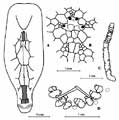The Echinoid Directory
Contributed by Andreas Kroh, July 2008
Solenocystis Mironov, 2008, p. 13
| Diagnostic Features |
|
|---|---|
| Distribution | Recent; Northern Atlantic. |
| Name gender | feminine |
| Type | Solenocystis imitans Mironov, 2008, p. 16, by original designation. RV G.O. Sars, MAR-ECO expedition, St. 72/386 (27 July 2004, 53 degrees16'N, 35 degrees 31'W, 2555-2517 m), Northern Atlantic Ocean; Holotype: Museum of Zoology, University Bergen, MAR-ECO 008141. |
| Species Included | Only the type species. |
| Classification and/or Status | Holasteroida, Meridosternata, Urechinina, Pourtalesiidae. |
| Remarks | Differs from Pourtalesia by its large labrum. Differentiated from Helgocystis by the presence of two plate pairs separating labrum and sternal plate, and labrum shape (triangular in Helgocystis). Differs from Echinosigra (Echinosigra) by its test shape (lack of a neck) and presence of 4 gonopores. Distinguished from Echinosigra (Echinogutta) by its test shape (lack of a neck) and the presence of two plate pairs separating labrum and sternal plate. Mironov, A. N. 2008. Pourtalesiid sea urchins (Echinodermata: Echinoidea) of the northern Mid-Atlantic Ridge. Marine Biology Research 4(1-2): 3-24. |



